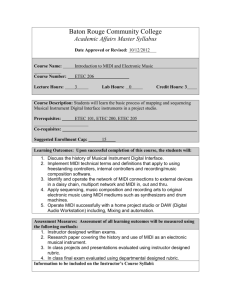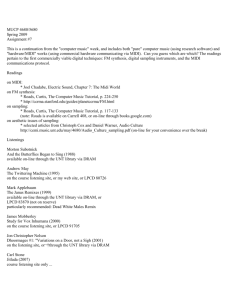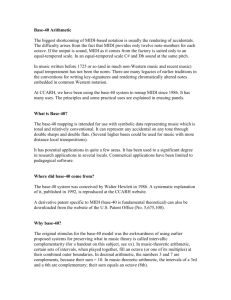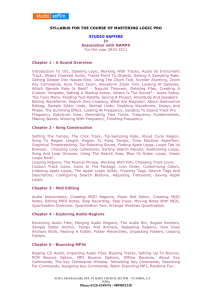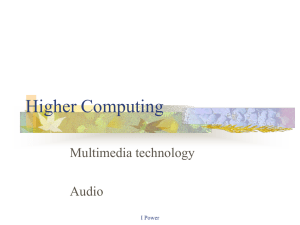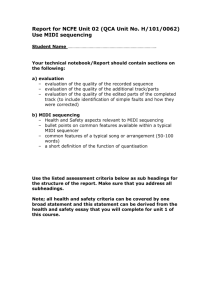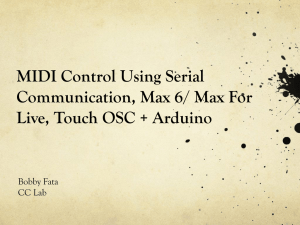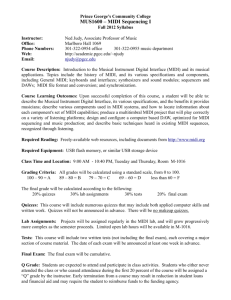MIDI on Linux
advertisement
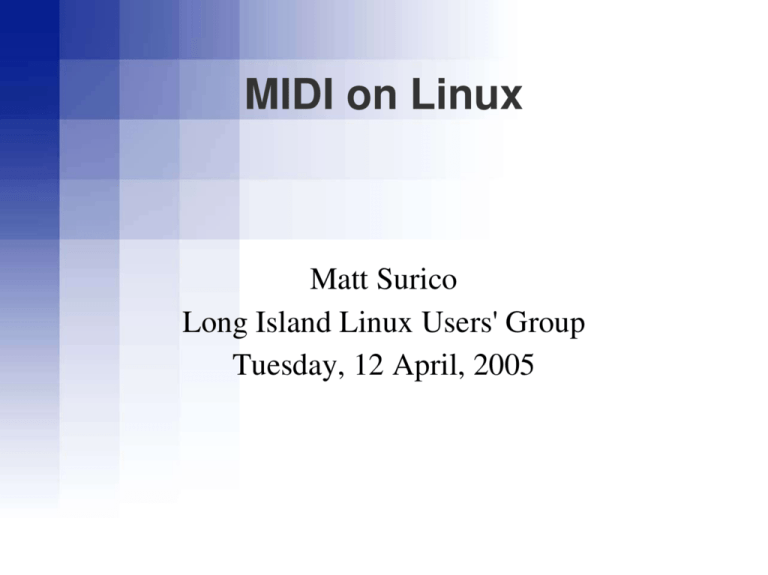
MIDI on Linux Matt Surico Long Island Linux Users' Group Tuesday, 12 April, 2005 Overview of Presentation ● ● ● ● What is MIDI? Putting together a MIDI Workstation running Linux Survey of Linux music tools Live demonstration of Rosegarden MIDI ● ● ● ● Musical Instrument Digital Interface Standard for connecting together music­ making devices A serial data protocol Origins in proprietary digital interfaces developed by manufacturers such as Roland, Oberheim, Fender Rhodes and Sequential Circuits MIDI: What it is and is not ● ● MIDI is not audio data!! Instead, it is a series of instructions to a piece of equipment to perform actions (turn a specific note on or off, increase volume of a note, etc.) MIDI ● ● ● ● First synth with MIDI: Prophet 600 in December 1982. First public demo of 2 synths connected together via MIDI at NAMM show, January, 1983 Version 1.0 of MIDI standard published in October 1983 The standard includes a hardware specification and a data specification MIDI Hardware Specification ● ● ● ● ● ● Asynchronous serial interface 31.25 Kbaud (+/­ 1%) Period = 320 microseconds per serial byte MIDI circuit is a 5 mA current loop Standard connector is a 5­pin DIN MIDI signal on pin 5, +5V bias on pin 4, pin 2 connected to cable shield (pins 1 & 3 are unused) MIDI Data Specification ● ● ● ● 1 start bit, 8 data bits, 1 stop bit 8 data bits = 1 byte MIDI messages generally are 1, 2 or 3 bytes long Logical 0 is ”on” MIDI Data Specification ● ● ● ● ● 8 data bits = 1 byte MIDI messages generally are 1, 2 or 3 bytes long First byte of the message is the status byte The status byte is the only MIDI message that has the 7th bit set (i.e., 128 thru 255, or 0x80 thru 0xFF). Therefore, data bytes have values 0­127 MIDI Data Example stop bit start bit 1 0 0 1 0 1 1 0 1/3125 second 1001 0110 = 150 decimal or 0x96 MIDI Messages ● ● ● Messages are sent to tell the equipment ”what to do” Remember: MIDI is not audio data!! Command set of MIDI includes messages to change a program (”patch”), sound a note value, apply a certain pressure to the note, and so forth MIDI Message Example ● ● ● ● ● 10010000 01000101 01100101 In hex, this 3­byte message is: 0x90 0x45 0x65 First byte = status byte; any status byte starting with hex 9 is a note on Second byte = note number (0x45 = 69th note above the bottom C, which is F above Middle C) Third byte = velocity MIDI Channels ● ● ● 16 logical channels Channel number encoded into bits 0­3 of the status byte From our previous example, 10010000 was the first byte, so 0x90 means ”status byte for channel 0”, or the first channel of 16. Building a Linux Digital Audio Workstation ● ● ● ● Dell Inspiron 9200, with 1 GB RAM and a Pentium M 2.0 Ghz CPU 7200 RPM 60 GB hard drive Firewire (IEEE 1394) Port – currently poorly supported for use in music by Linux Two USB 2.0 ports Goal of Linux DAW ● ● ● Create a working environment to produce music both in studio form (recording) as well as for live performances Use as little proprietary software as possible Keep costs low Problems using Linux as a DAW ● ● ● ● Latency – need a tuned kernel Need professional quality audio managment on the PC Need professional sound sources Firewire support in its infancy under Linux Linux Distributions for Making Music ● ● ● ● Most modern distributions will form a good ”backbone” Still need to tune the kernel There are suites of programs and applications packaged for running a Linux DAW Debian and RPM format AGNULA ● ● ● ● AGNULA – A GNU/Linux Audio Distribution Consortium of several European universities, RedHat Linux, and the Free Software Foundation Completely customized distribution for making music Available in both Debian and RPM formats Planet CCRMA ● ● Stanford University Center for Computer Research in Music and Acoustics Linux music applications wrapped in RPM format, distributed along with a low­latency kernel Getting started installing the software ● Fedora Core 3 installed Planet CCRMA obtained from http://ccrma.stanford.edu ● Available for Fedora Core 1,2 and 3 ● Setting up ● ● Download/install the GPG signature for Planet CCRMA Install apt [root@syrinx ~]# rpm --import http://ccrma.stanford.edu/planetccrma/RPM-GPGKEY.planetccrma.txt [root@syrinx ~]# rpm -Uvh http://ccrma.stanford.edu/planetccrma/apt/rpms/a pt-0.5.15cnc6-3.rhfc3.ccrma.i386.rpm Setting up ● ● ● Do apt­get update, then install the core Note current kernel was 2.6.9­1.667 before the CCRMA modifications Can also try the ”bleeding edge kernel” [root@syrinx ~]# apt-get update [root@syrinx ~]# apt-get install planetccrma-core [root@syrinx ~]# apt-get install planetccrma-coreedge Contents of the CCRMA core ● ● ● Kernel 2.6.10 (bleeding edge is 2.6.11) ALSA goodies (tools, libraries, modules) GRUB bootloader configuration automagically updated Installing CCRMA packages ● Can install RPMs one by one or ”go for broke” and install the whole kit [root@syrinx ~]# apt-get install planetccrmaaudioapps What Audio/MIDI applications are available? ● Can install RPMs one by one or ”go for broke” and install the whole kit [root@syrinx ~]# apt-get install planetccrmaaudioapps Components for successful Linux Audio/MIDI : ALSA ● ● ● ● ● ● ● ALSA – Advanced Linux Sound Architecture A huge improvement over the Open Sound System Potentially can support all types of audio interfaces Modular sound drives SMP and thread­safe design Uses alsa­lib (user space library) to make application programming easier Supports the older OSS API Components for successful Linux Audio/MIDI : JACK ● ● ● ● ● JACK – Jack Audio Connection Kit Low latency audio server Designed for POSIX compliant operating systems Allows connectivity of a variety of applications to an audio device, and allows for sharing of audio between them Allows for applications to run ”normally” (as standalone apps) or within the JACK server (as a ”plugin”) Components for successful Linux Audio/MIDI : LADSPA ● ● LADSPA – Linux Audio Developers Simple Plug­In API Allows for virtual instruments and effects (audio processors) to be used in a sequencer environment MIDI Sequencers ● ● ● ● ● ● ● MusE anthem JAZZ++ TekTracker Tutka seq24 Rosegarden MIDI Players and other Utilities ● ● ● ● TiMidity++ Xpmidi ALSA Midi Patch Bay QmidiArp Synthesizers ● ● ● ● ● ● ● FluidSynth (and Qsynth) Hydrogen – ultimate drum machine ZynAddSubFX – hybrid of additive and subtractive synthesis gmorgan amsynth – subtractive synthesis ALSA modular synth SpiralSynth Audio Applications ● ● ● ● ● Audacity Ardour Galan pd qarecord VSTs ● ● ● ● VST = Virtual Studio Technology A means of plugging in virtual instruments (VSTi) and audio processors to a music software environment (e.g., a sequencer) Developed by Steinberg Main platforms are Mac and PC VSTs under Linux ● ● Running Windows compatible VSTs under Linux – vstserver project – fst server – dssi­vst wrapper vstserver: – Uses WINE (to run vstserver itself) – LADSPA host plugin for VST plugins (vst.so) – Includes standalone host application to run VSTis Rosegarden Demo ● ● ● How does the hardware fit together? What software is running? How can we build a song snippet?

